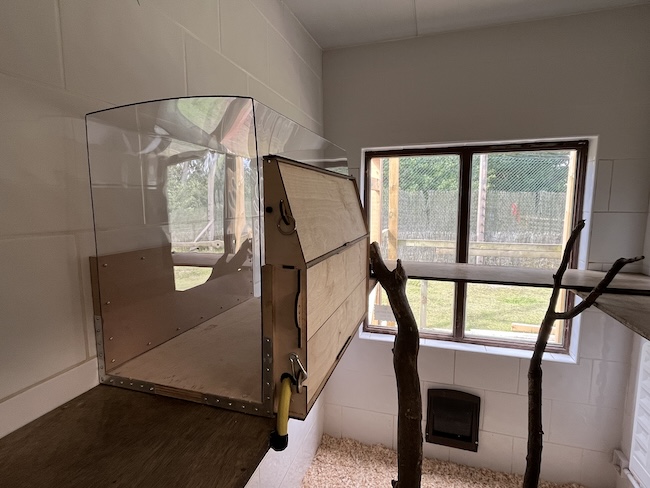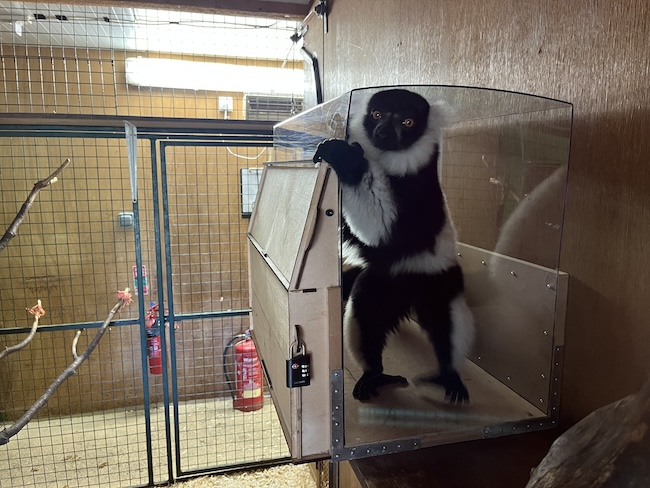‘LemurLounge’ offers zoo animals the chance to chill to sounds of their choosing
Published: 9 April 2024
Researchers from the University of Glasgow have teamed up with zookeepers at Blair Drummond Safari Park to explore whether interactive technology that lets zoo lemurs play sounds on demand could enrich their everyday lives.
Researchers from the University of Glasgow have teamed up with zookeepers at Blair Drummond Safari Park to explore whether interactive technology that lets zoo lemurs play sounds on demand could enrich their everyday lives.
To test whether lemurs might choose to trigger sounds when given the chance, the researchers built what they called a ‘LemurLounge’ – a wooden box lined with infrared sensors that played one of a rotating selection of sounds when the animals entered.
The system, the first of its kind to be tested with lemurs, suggests that although they have no single favourite type of sound, they do seem to prefer sound over silence when given the choice. Their interactions also vary across species and between individuals within species groups, which could suggest that, like humans, lemurs have their own preferences for how they interact with devices.
The findings could help inform the development of more fully-featured digital enrichment systems for lemurs living in zoos, and help advance the emerging field of animal-computer interaction.
The outcomes of the research will be presented as a paper at the Association of Computing Machinery CHI conference on Human Factors in Computing Systems next month.

The prototype LemurLounge was installed in lemur enclosures at Blair Drummond, which is home to black-and-white, brown and ring-tailed lemurs – 14 animals in total. The LemurLounge was installed in one enclosure for several weeks before moving to a second enclosure.
Speakers inside the box played the sounds of a rainforest, city noise, upbeat music, calm music or white noise for as long as the lemurs chose to remain in the lounge. From time to time during the study, the speakers played no audio at all to help determine if the lemurs preferred to have quiet time inside the LemurLounge.
Over the course of eight weeks, the lemurs could visit the LemurLounge whenever they wanted. Across the group, they averaged three sessions in the LemurLounge each day, lasting around 30 seconds in total. The lemurs visited the LemurLounge more often when the speakers played sounds rather than offering silence, suggesting they preferred some kind of audio stimuli over a quiet environment. Of the sounds they listened to, the rainforest, traffic sounds and music were triggered with roughly the same frequency.
The researchers noted that the animals’ preferences seemed to vary across the three species which shared access to the LemurLounge. Common brown lemurs triggered sounds for around two seconds at a time, while their black-and-white and ring-tailed counterparts stayed longer, for about four seconds. Older lemurs also spent more time with triggered sounds than their younger counterparts, and played them more often.

The team also observed significant variation in interactions with the LemurLounge between individual lemurs in the three species groups. One black-and-white lemur, for example, interacted with LemurLounge twice as much as the others in his species group, and spent four times as much time there. Another triggered music most frequently and chose white noise the least, while two others did the exact opposite.
The research is the latest outcome of an ongoing partnership between zookeepers at Blair Drummond Safari Park and researchers at the University of Glasgow’s School of Computing Science, led by Dr Ilyena Hirskyj-Douglas.
Previous research collaborations between the zoo and the university have included the development of the world’s first interactive enrichment system for giraffes. Dr Hirskyj-Douglas has also led related research projects which investigated white-faced saki monkeys’ response to interactive audio in their enclosures.
Dr Hirskyj-Douglas said: “Technology offers us the opportunity to enrich the lives of zoo animals with interactive systems that are custom-designed for their physical and mental needs, interests and abilities. However, in order to make the most of the potential of interactive devices, it’s vital that we take their preferences into account. As much as we can, we want to design systems in collaboration with them rather than trying to decide what they might want for ourselves.
“Our partnership with Blair Drummond Safari Park is gives us the chance to start mapping out what a future of animal-computer interaction might look like. It builds on a wealth of previous research showing that audio enrichment could benefit zoo animals’ wellbeing.
“This research is the first time that zoo-housed lemurs have been given the opportunity to interact with a computer enrichment device. Their reactions to the LemurLounge gives us fresh insight into their behaviour and preferences, and could help inform the development of systems for lemurs and other species in the future.”
Vilma Kankaanpää, of the University of Glasgow’s School of Computing Science, is the paper’s corresponding author. She said: “There’s much more variation apparent in their behaviour than we saw with similar saki monkey studies. Part of that of may be down to differences between cohabitating species as well as individual preferences, which are factors that haven’t been explored much in previous studies.
“Our findings suggest that future enrichment systems for animals of different species which live together in enclosures should take the variation in their preferences into account at the design stage.
“The computer systems humans use in our everyday lives were developed through intensive research into users’ needs and preferences. In order to build the best possible interactive systems for animals in the future, we’ll need similarly focused research into what works for them. This study is one step further towards a future where zoo animals have access to digital devices which can enrich their lives.”
Alasdair Gillies, Blair Drummond Safari Park’s Research Coordinator, said: “We are delighted to be part of the push to bring interactive systems into more common usage as enrichment devices. It’s very interesting to hear this study has shown that individual preference may be just as significant to the design process as species variation.
“For us keepers, these findings come as no surprise. Our interactions with these animals grant us the privilege of witnessing their many varied idiosyncrasies on a daily basis. It will be fascinating to see how we can utilise these learnings going forward.”
Dr Fay Clark, from the University of Bristol, also contributed to the research and co-authored the paper.
The team’s paper, titled ‘LemurLounge: Lemurs’ Individual-Level, Group, and Cross-Species Use of an Interactive Audio Device in Zoos’, will be presented at the Association of Computing Machinery’s CHI conference on Human Factors in Computing Systems next month.
First published: 9 April 2024

